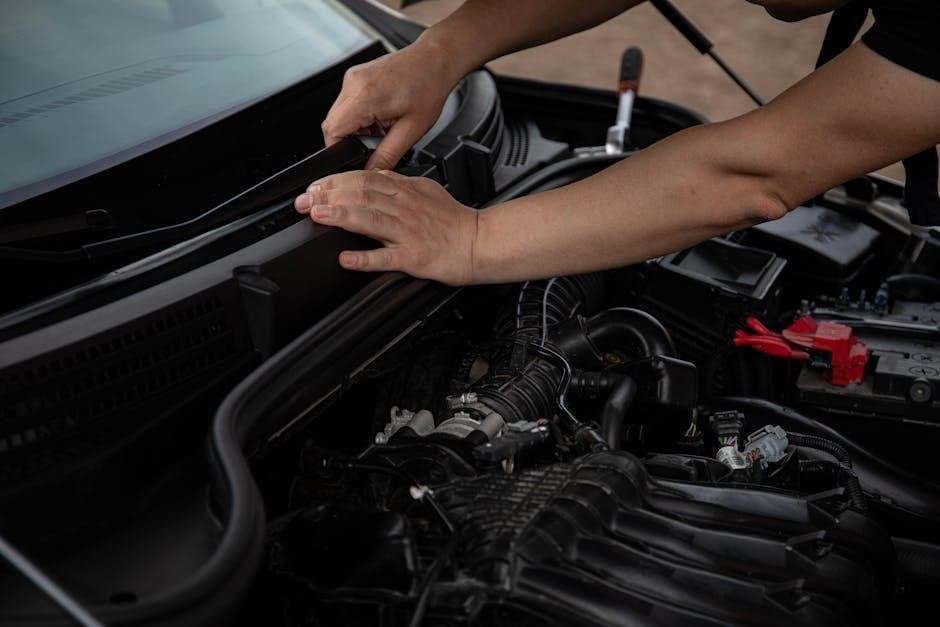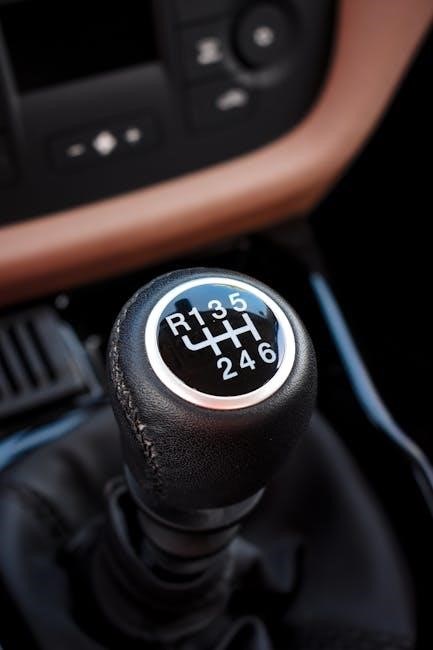The manual Mustang transmission embodies the essence of driving purism, offering unparalleled control and engagement․ With a rich heritage and precise shifting, it defines the Mustang experience․

Overview of Manual Transmissions in Ford Mustang
Manual transmissions in the Ford Mustang have long been a cornerstone of its performance legacy, offering drivers direct control and a visceral connection to the vehicle․ The current lineup, such as the 2024 Mustang GT, features the Getrag MT82 six-speed manual transmission, known for its smooth shifting and durability․ Historically, models like the T5 and TR-3650 have provided reliable and engaging driving experiences․ Ford’s commitment to manual transmissions continues, with the 2025 Mustang promising to retain this option alongside V8 engines․ Even as the automotive world evolves, the manual Mustang remains a symbol of driving purism, blending tradition with modern engineering to deliver unparalleled driver engagement and satisfaction․
Importance of Manual Transmissions in Performance Cars
Manual transmissions are integral to the performance ethos of cars like the Ford Mustang, offering drivers unparalleled control and connection to the vehicle․ They enable precise gear selection, allowing for optimal acceleration and responsiveness, especially in high-performance scenarios․ Manual transmissions are generally lighter and more fuel-efficient than their automatic counterparts, which can enhance handling and overall driving dynamics․ Additionally, the tactile experience of shifting gears fosters a deeper engagement between the driver and the car, making it a preferred choice for enthusiasts․ In performance cars, manual transmissions not only enhance driving enjoyment but also provide a cost-effective solution for delivering power directly to the wheels, ensuring a more immersive and rewarding driving experience․
History of Manual Transmissions in Ford Mustang
The Ford Mustang’s manual transmission history began in 1965 with a four-speed, evolving through five-speed and modern six-speed units like the MT82, becoming an iconic performance hallmark․
Early Models: The Four-Speed Manual Transmission (1965)
The 1965 Ford Mustang introduced the iconic four-speed manual transmission, marking a pivotal moment in performance driving․ This transmission, synonymous with the Shelby GT350, GT500, Boss 302, and Boss 429, became a hallmark of Mustang’s legacy․ Known for its durability and precise shifting, the four-speed offered drivers direct control and an engaging experience; It was the first four-speed manual offered in the Mustang lineup, catering to enthusiasts who craved a more connected driving experience․ This transmission laid the foundation for future manual units, solidifying the Mustang’s reputation as a performance icon․ Its introduction not only enhanced the car’s capabilities but also cemented the manual transmission’s role in the Mustang’s identity․
Evolution of Manual Transmissions Through the Years
The manual transmission in the Ford Mustang has undergone significant evolution since its debut․ Starting with the four-speed in 1965, it progressed to the five-speed T5 in the 1980s, known for its durability and widespread use․ The 1990s introduced the TR-3650 and T45, offering improved gear ratios and strength․ In the 2000s, the MT82 six-speed became standard, featuring a modern design with closer gear spacing and smoother shifting․ Each generation brought enhancements in materials, engineering, and performance capabilities, ensuring the manual transmission remained central to the Mustang’s driving experience․ These advancements have catered to both enthusiasts and the demands of increasingly powerful engines, solidifying the manual’s role in the Mustang’s legacy․
Legendary Models: Shelby GT350, GT500, and Boss Series
The Shelby GT350, GT500, and Boss series are iconic Mustangs that championed the manual transmission․ The GT350, introduced in 1965, featured a four-speed manual, embodying race-ready precision․ The GT500, with its powerful V8, relied on a robust manual to deliver unmatched performance․ The Boss series, particularly the Boss 302 and 429, further cemented the manual’s reputation for durability and responsiveness․ These models showcased how manual transmissions could optimize power delivery, making them central to their legendary status․ Each iteration highlighted the manual’s ability to enhance driving dynamics, solidifying its place in Mustang history and enthusiast culture․

Types of Manual Transmissions in Ford Mustang
Ford Mustang manual transmissions include the T5, TR-3650, T45, MT82, and MT82-D4, each offering unique gear ratios and applications tailored to specific Mustang models and engine configurations․
T5 Transmission: Features and Applications
The T5 transmission is a five-speed manual gearbox known for its durability and simplicity․ Introduced in the late 1980s, it became a staple in Fox Body Mustangs, offering smooth shifting and a compact design․ The T5 features a fully synchronized gearset with a 10-spline input shaft and 28-spline output shaft, making it suitable for a variety of engine configurations․ Its lightweight aluminum case and robust construction allowed it to handle increased power outputs over time․ The T5 was widely used in Mustangs until the mid-1990s, earning a reputation for reliability and versatility․ Today, it remains a popular choice for enthusiasts seeking a classic manual driving experience․
TR-3650 and T45 Transmissions: Unique Characteristics
The TR-3650 and T45 transmissions are notable for their distinct designs and applications in Ford Mustangs․ The TR-3650, a five-speed manual, is known for its robust construction, featuring a strong case and internal components capable of handling high-performance engines․ It was commonly used in late 90s to early 2000s Mustangs, particularly in Cobra models․ The T45, another five-speed, is lighter and more compact, with a simpler design, making it ideal for everyday driving․ Both transmissions offer fully synchronized gears for smooth shifting․ While the TR-3650 is favored for its durability and strength, the T45 is appreciated for its lightweight and ease of use․ These transmissions played pivotal roles in enhancing the Mustang’s driving experience during their respective eras․
MT82 and MT82-D4: Modern Six-Speed Manual Transmissions
The MT82 and MT82-D4 are advanced six-speed manual transmissions designed for modern Ford Mustangs․ The MT82, introduced in 2011, is known for its durability and smooth shifting, making it a popular choice for V8-powered Mustangs․ It features a robust design with optimized gear ratios for both performance and fuel efficiency․ The MT82-D4, a variant of the MT82, is tailored for four-cylinder engines, offering unique gear ratios that enhance acceleration and responsiveness․ Both transmissions are praised for their precise engagement and driver engagement, embodying the spirit of manual driving; These modern units strike a balance between performance and practicality, solidifying their place in the Mustang’s legacy of exceptional manual transmissions․

Pros and Cons of Manual Mustang Transmission
Manual Mustang transmissions offer exceptional control and driving engagement, making them a favorite among enthusiasts․ However, they require more skill and attention compared to automatics․

Advantages: Control, Cost, and Driving Engagement
Manual transmissions in Ford Mustangs provide direct control over performance, allowing drivers to optimize speed and torque for varying conditions․ This precision enhances acceleration and responsiveness․ Cost-wise, manual transmissions are generally more affordable than automatics, both in purchase and maintenance․ They also deliver a more engaging driving experience, fostering a connection between the driver and the vehicle․ Enthusiasts appreciate the tactile feedback and the thrill of shifting gears, making manual Mustangs a preferred choice for those who value driving dynamics and affordability․
Disadvantages: Complexity and Skill Requirements
Manual transmissions require a higher level of driver skill and attention, as they demand precise clutch operation and gear shifting․ This can be challenging for inexperienced drivers, especially in heavy traffic or hilly terrain․ The complexity of manual transmissions also means more maintenance over time, such as clutch replacements, which can add to long-term costs․ Additionally, the need for constant engagement with the vehicle can be tiring on long drives․ While many enthusiasts appreciate the connection to the car, others find the demands of a manual transmission less practical for everyday use․ Despite these drawbacks, the unique driving experience often outweighs the challenges for passionate drivers․


Maintenance and Care for Manual Mustang Transmission
Regular maintenance is crucial for the longevity of a manual Mustang transmission․ This includes timely transmission fluid changes, clutch inspections, and ensuring proper gear alignment to prevent wear․
Transmission Fluid: Importance and Replacement
Transmission fluid is vital for lubricating gears, reducing friction, and preventing overheating in a manual Mustang transmission․ Regular fluid replacement ensures smooth gear shifts and extends transmission life․ Owners should use the manufacturer-recommended fluid type and follow the specified interval, typically every 30,000 to 60,000 miles․ Neglecting fluid changes can lead to premature wear and potential failure․ A clean fluid also helps maintain optimal performance and prevents contaminants from damaging internal components․ Always refer to the owner’s manual for specific guidelines on fluid replacement and capacity to ensure the longevity of the manual transmission system in your Ford Mustang․ Proper maintenance here is key to a seamless driving experience․
Clutch Maintenance: Tips for Longevity

Regular clutch maintenance is essential to ensure optimal performance and extend the life of your manual Mustang transmission․ Inspect the clutch assembly periodically for wear, such as excessive play or friction material degradation․ Replace worn components promptly to avoid costly repairs․ Avoid “riding the clutch,” as this generates excessive heat and accelerates wear․ Ensure the clutch pedal is properly adjusted to maintain the correct engagement point․ Smooth, gradual shifts and avoiding abrupt acceleration can also reduce strain on the clutch․ Finally, consult a professional for any signs of slipping or unusual noise, as early intervention prevents major failures and keeps your Mustang’s manual transmission running smoothly for years․

Common Problems and Fixes
Common problems include clutch wear, fluid leaks, and synchronizer issues․ Fixes involve replacing components, using synthetic fluid, and regular professional repairs for optimal performance and durability․
Reasons for Manual Transmission Failure
Manual transmission failure in Ford Mustangs often stems from clutch wear, excessive heat, and fluid contamination․ High mileage and aggressive driving can lead to bearing wear and gear damage․ The MT82, T5, and TR-3650 transmissions are prone to issues like synchro damage and input shaft failure․ Overloading the transmission or ignoring maintenance can exacerbate these problems․ Symptoms include grinding gears, slipping, or difficulty shifting․ Failure can result from a combination of these factors, emphasizing the importance of regular maintenance and fluid changes․ Addressing issues early prevents costly repairs and ensures optimal performance․
DIY Repairs and Professional Solutions
DIY repairs for manual Mustang transmissions are feasible for minor issues like clutch replacements or seal leaks, but require mechanical skill․ Owners can source parts from eBay or CJ Pony Parts․ For major repairs, such as gear or bearing replacement, professional expertise is recommended․ Transmission shops specialize in overhauls and can refurbish or replace components like the MT82 or T5․ Proper tools and knowledge are crucial to avoid further damage․ Regular maintenance, like fluid changes, can prevent premature wear․ However, complex issues like synchro or input shaft failure often demand professional intervention․ Balancing DIY efforts with professional solutions ensures longevity and performance of the manual transmission system․

Future of Manual Transmissions in Ford Mustang
Ford has committed to offering manual transmissions in the 2025 Mustang models․ There’s also exploration into integrating manual transmissions in future electric Mustangs․
Commitment to Manual Transmissions in 2025 Models
Ford has reaffirmed its dedication to manual transmissions in the 2025 Mustang lineup, ensuring enthusiasts can still enjoy the classic three-pedal driving experience․ This commitment underscores the Mustang’s heritage;
Electric Mustang and Manual Transmission Possibilities
Ford is exploring the integration of manual transmissions into electric Mustangs, blending tradition with innovation․ A patent reveals potential for a manual transmission in future electric models, offering drivers the unique experience of manual shifting combined with electric power․ This approach could appeal to enthusiasts who value driving engagement․ However, adapting manual transmissions to electric vehicles presents technical challenges, such as synchronizing shifts with electric motors․ Despite these hurdles, Ford’s commitment to preserving the manual transmission highlights its dedication to driver connection and performance heritage, ensuring the Mustang remains iconic in an evolving automotive landscape․
The manual Mustang transmission remains a timeless symbol of automotive heritage, blending tradition with modern engineering, offering unparalleled driver engagement and ensuring its iconic legacy endures in both classic and future models․
Final Thoughts on Manual Mustang Transmission
The manual Mustang transmission represents more than just a gear-shifting mechanism—it symbolizes a connection to the car’s heritage and driving passion․ With models like the 2024 Mustang GT featuring the MT82 six-speed manual, Ford continues to honor this tradition, offering drivers precise control and an immersive experience․ The commitment to manual transmissions in 2025 models underscores Ford’s dedication to enthusiast drivers․ Even as the automotive world evolves, the manual Mustang transmission remains a beloved icon, blending nostalgia with modern performance․ Its enduring appeal lies in the tactile engagement it provides, making every drive a memorable journey․ Whether in classic models or future electric iterations, the manual transmission ensures the Mustang’s spirit endures․
Why Manual Transmissions Remain Iconic in Ford Mustang
Manual transmissions are deeply ingrained in the Ford Mustang’s identity, symbolizing a connection to its heritage and the essence of driving purism․ Since the 1960s, the manual gearbox has been synonymous with the Mustang’s performance legacy, evoking memories of iconic models like the Shelby GT350 and GT500․ The tactile experience of shifting gears creates a bond between driver and car, making it more than just a mechanical component—it’s an emotional link to the Mustang’s history․ Even as automotive technology advances, the manual transmission remains a cherished feature, embodying the spirit of enthusiast driving․ Its enduring presence in modern Mustangs, including the 2025 models, ensures that this iconic trait continues to resonate with driving purists worldwide․





